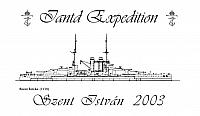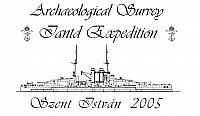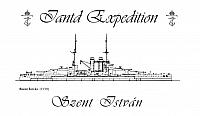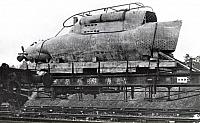Corazzata Szent Istvàn
Nel giugno del 1918 il Capo di Stato Maggiore della Marina Austro-Ungarica ammiraglio Nikolaus Horthy, futuro dittatore dell’Ungheria, pianificò un’incursione contro lo sbarramento navale di Otranto che ostruiva l’accesso al mare aperto alla Marina Asburgica, confinata nel Mar Adriatico; contemporaneamente avrebbe dovuto aver luogo un’offensiva sulla fronte del Piave.
La squadra navale con le corazzate Szent István e Tegetthoff salpò da Pola il 9 di Giugno 1918.
All’alba del 10 Giugno il capitano di corvetta Luigi Rizzo, impegnato con i Mas 15 e 21 in un’operazione di rastrellamento di mine al largo dell’isolotto di Lutrosnjak, entrò fortuitamente in contatto con la flotta Austro-Ungarica.
Sfruttando al meglio le caratteristiche dei veloci motoscafi anti-sommergibili, grazie ad un coraggioso ed occulto avvicinamento, a meno di 500mt. di distanza Rizzo riuscì nell’intento di affondare la corazzata Szent István (Santo Stefano), fiore all’occhiello della marina nemica.
Il contraccolpo psicologico dell’azione ebbe ripercussioni morali talmente forti da impedire nel corso della Grande Guerra qualsiasi altra operazione navale alla monarchia mitteleuropea e da divenire ad oggi la data della Festa della Marina Militare Italiana.
Oggi questo importante relitto è sottoposto alla attenta tutela del Governo della Repubblica di Croazia.
In Juny 1918 the Chief of Staff of the Austro-Hungarian Navy admiral Nikolaus Horthy, future dictator of Hungary, planned a raid against the naval barrage of Otranto that blocked the free passage to the open sea to the Austro-Hungarian Navy, confined in the Adriatic Sea; at the same time should have taken place an offensive on the Piave frontline.
The naval squadron with the battleship Szent Istvan and Tegetthoff left Pola on the 9th June 1918.
At dawn of 10th June the Italian Navy lieutenant commander Luigi Rizzo, was engaged with the Mas 15 and 21 in a mine-sweeping operation off Lustrosnjak islet, by chance he saw the Austro-Hungarian fleet sailing southward. Taking best advantage of the features of his anti-submarines speedboats, thanks to a brave and hidden approach, at less then 500 m of distance Rizzo reached the aim to sink the battleship Szent Istvan (Santo Stefano), pride of the enemy navy.
The Austro-Hungarian psychology reaction to this action had so heavy negative moral repercussions to avoid any other naval operation of the Augsburg monarchy during the rest of WWI and that day became the date of the of the Italian Navy remembrance day.
Today this important wreck is subject to the care and protection of the government of the Republic of Croatia.
La squadra navale con le corazzate Szent István e Tegetthoff salpò da Pola il 9 di Giugno 1918.
All’alba del 10 Giugno il capitano di corvetta Luigi Rizzo, impegnato con i Mas 15 e 21 in un’operazione di rastrellamento di mine al largo dell’isolotto di Lutrosnjak, entrò fortuitamente in contatto con la flotta Austro-Ungarica.
Sfruttando al meglio le caratteristiche dei veloci motoscafi anti-sommergibili, grazie ad un coraggioso ed occulto avvicinamento, a meno di 500mt. di distanza Rizzo riuscì nell’intento di affondare la corazzata Szent István (Santo Stefano), fiore all’occhiello della marina nemica.
Il contraccolpo psicologico dell’azione ebbe ripercussioni morali talmente forti da impedire nel corso della Grande Guerra qualsiasi altra operazione navale alla monarchia mitteleuropea e da divenire ad oggi la data della Festa della Marina Militare Italiana.
Oggi questo importante relitto è sottoposto alla attenta tutela del Governo della Repubblica di Croazia.
In Juny 1918 the Chief of Staff of the Austro-Hungarian Navy admiral Nikolaus Horthy, future dictator of Hungary, planned a raid against the naval barrage of Otranto that blocked the free passage to the open sea to the Austro-Hungarian Navy, confined in the Adriatic Sea; at the same time should have taken place an offensive on the Piave frontline.
The naval squadron with the battleship Szent Istvan and Tegetthoff left Pola on the 9th June 1918.
At dawn of 10th June the Italian Navy lieutenant commander Luigi Rizzo, was engaged with the Mas 15 and 21 in a mine-sweeping operation off Lustrosnjak islet, by chance he saw the Austro-Hungarian fleet sailing southward. Taking best advantage of the features of his anti-submarines speedboats, thanks to a brave and hidden approach, at less then 500 m of distance Rizzo reached the aim to sink the battleship Szent Istvan (Santo Stefano), pride of the enemy navy.
The Austro-Hungarian psychology reaction to this action had so heavy negative moral repercussions to avoid any other naval operation of the Augsburg monarchy during the rest of WWI and that day became the date of the of the Italian Navy remembrance day.
Today this important wreck is subject to the care and protection of the government of the Republic of Croatia.
- Primo Precedente
- Foto 1 - 4 di 4
- Prossimo Ultimo




